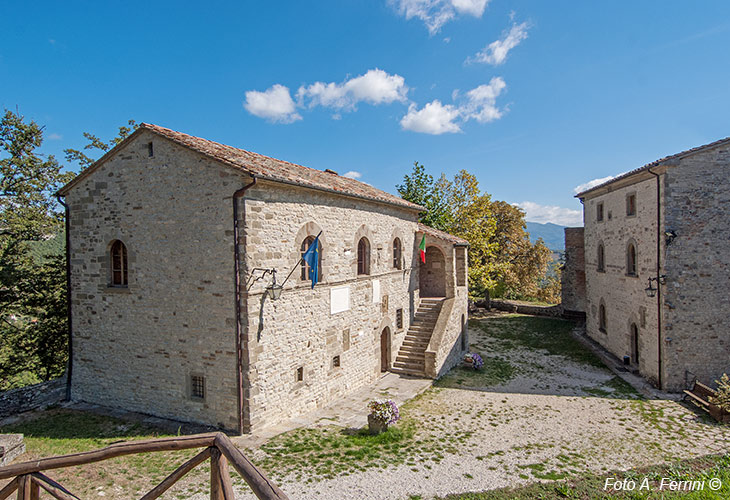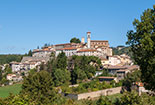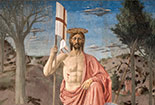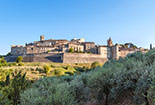CAPRESE MICHELANGELO
in Valtiberina, the land of Piero Della Francesca, the first bathed by the Tiber

Texts and photos by Alessandro Ferrini ©
33 accurately described images of Caprese Michelangelo. Click to enlarge
Caprese Michelangelo, a village on the slopes of Alpe di Catenaia
 Caprese Michelangelo is located on the Provincial Road that runs along the slopes of the Alpe di Catenaia facing the Valtiberina.
A consolidated tradition traces the origins of this village to a Lombard settlement, the known history of the place begins, however, in the 11th century when the presence of a castle is documented. This, and the surrounding area, in the early twelfth century entered the possessions of the Camaldolese. From 1226 begins a period of a century and a half which saw the Castle of Caprese subjected to various domains. In 1384, the place submitted to Florence which in the early fifteenth century established a Podesta office there after having restored the walls of the castle which had been damaged by a siege of Arezzo in the 1920s. Among the Podestà who administered Caprese was a certain Ludovico Buonarroti, father of the much more famous Michelangelo, who was in Caprese with his wife on 6 March 1475, the birth day of the Renaissance artist. Michelangelo Buonarroti was born, therefore, in this remote place on the eastern slopes of the Alpe di Catenaia. From the end of the XVI century the Castle of Caprese started towards decay. In the second half of the nineteenth century there was the discovery of the birth certificate of the great sculptor, painter, architect. This made the place acquire great prestige, which was renamed in Caprese Michelangelo and its fortress underwent a profound restoration. A first exhibition dedicated to the artist was born who over the years has grown in quantity of material and quality. Today it has taken the name of Michelangelo Buonarroti Birthplace Museum and is spread over three buildings and an outdoor exhibition space.
Just outside what used to be the castle walls is the small church of San Giovanni Battista. Its origin dates back to the early 13th century. Particularly pleasant is the bell tower above the façade which houses two bells one of which dates back to 1297. Inside there is a 15th century tabernacle made by the Tuscan sculptor Cristofano di Landuccio (1419 - 1492). According to tradition, Michelangelo Buonarroti was baptized in this church on 8 March 1475. This thing is remembered by a plaque placed on the facade.
In the locality of Tifi, not far from the town, there is the church of what was once the Camaldolese abbey of San Martino founded according to tradition by San Romualdo himself. The abbey is mentioned for the first time in a document dated 1057. In this church there was the triptych with the Virgin and Child between saints made by Giuliano Amidei in 1475, an illuminator and painter monk. The panel painting is now on display
Caprese Michelangelo is located on the Provincial Road that runs along the slopes of the Alpe di Catenaia facing the Valtiberina.
A consolidated tradition traces the origins of this village to a Lombard settlement, the known history of the place begins, however, in the 11th century when the presence of a castle is documented. This, and the surrounding area, in the early twelfth century entered the possessions of the Camaldolese. From 1226 begins a period of a century and a half which saw the Castle of Caprese subjected to various domains. In 1384, the place submitted to Florence which in the early fifteenth century established a Podesta office there after having restored the walls of the castle which had been damaged by a siege of Arezzo in the 1920s. Among the Podestà who administered Caprese was a certain Ludovico Buonarroti, father of the much more famous Michelangelo, who was in Caprese with his wife on 6 March 1475, the birth day of the Renaissance artist. Michelangelo Buonarroti was born, therefore, in this remote place on the eastern slopes of the Alpe di Catenaia. From the end of the XVI century the Castle of Caprese started towards decay. In the second half of the nineteenth century there was the discovery of the birth certificate of the great sculptor, painter, architect. This made the place acquire great prestige, which was renamed in Caprese Michelangelo and its fortress underwent a profound restoration. A first exhibition dedicated to the artist was born who over the years has grown in quantity of material and quality. Today it has taken the name of Michelangelo Buonarroti Birthplace Museum and is spread over three buildings and an outdoor exhibition space.
Just outside what used to be the castle walls is the small church of San Giovanni Battista. Its origin dates back to the early 13th century. Particularly pleasant is the bell tower above the façade which houses two bells one of which dates back to 1297. Inside there is a 15th century tabernacle made by the Tuscan sculptor Cristofano di Landuccio (1419 - 1492). According to tradition, Michelangelo Buonarroti was baptized in this church on 8 March 1475. This thing is remembered by a plaque placed on the facade.
In the locality of Tifi, not far from the town, there is the church of what was once the Camaldolese abbey of San Martino founded according to tradition by San Romualdo himself. The abbey is mentioned for the first time in a document dated 1057. In this church there was the triptych with the Virgin and Child between saints made by Giuliano Amidei in 1475, an illuminator and painter monk. The panel painting is now on display  in Michelangelo's birthplace. Among the saints we find San Benedetto and San Romualdo. This presence leaves no doubt about the monks of Camaldoli as clients of the work.
For centuries Caprese Michelangelo has drawn economic sustenance from pastoralism, poor agriculture, working in the forest. Chestnuts were a particularly important product and they still have its importance in the local economy today. To remember and honor the importance of this fruit, the Chestnut Festival is held in the small village every year in the second half of October.
Caprese can be the starting point for walks on beautiful paths through oak, chestnut and beech woods on the slopes of the Alpe di Catenaia.
From the town in less than ten kilometers you can reach the Montedoglio reservoir built in the 1980s on the Tiber River which has its source about thirty kilometers earlier on Mount Fumaiolo. It is the largest lake in Tuscany and despite being something artificial, its landscape and naturalistic value for the Valtiberina is enormous.
in Michelangelo's birthplace. Among the saints we find San Benedetto and San Romualdo. This presence leaves no doubt about the monks of Camaldoli as clients of the work.
For centuries Caprese Michelangelo has drawn economic sustenance from pastoralism, poor agriculture, working in the forest. Chestnuts were a particularly important product and they still have its importance in the local economy today. To remember and honor the importance of this fruit, the Chestnut Festival is held in the small village every year in the second half of October.
Caprese can be the starting point for walks on beautiful paths through oak, chestnut and beech woods on the slopes of the Alpe di Catenaia.
From the town in less than ten kilometers you can reach the Montedoglio reservoir built in the 1980s on the Tiber River which has its source about thirty kilometers earlier on Mount Fumaiolo. It is the largest lake in Tuscany and despite being something artificial, its landscape and naturalistic value for the Valtiberina is enormous.











































